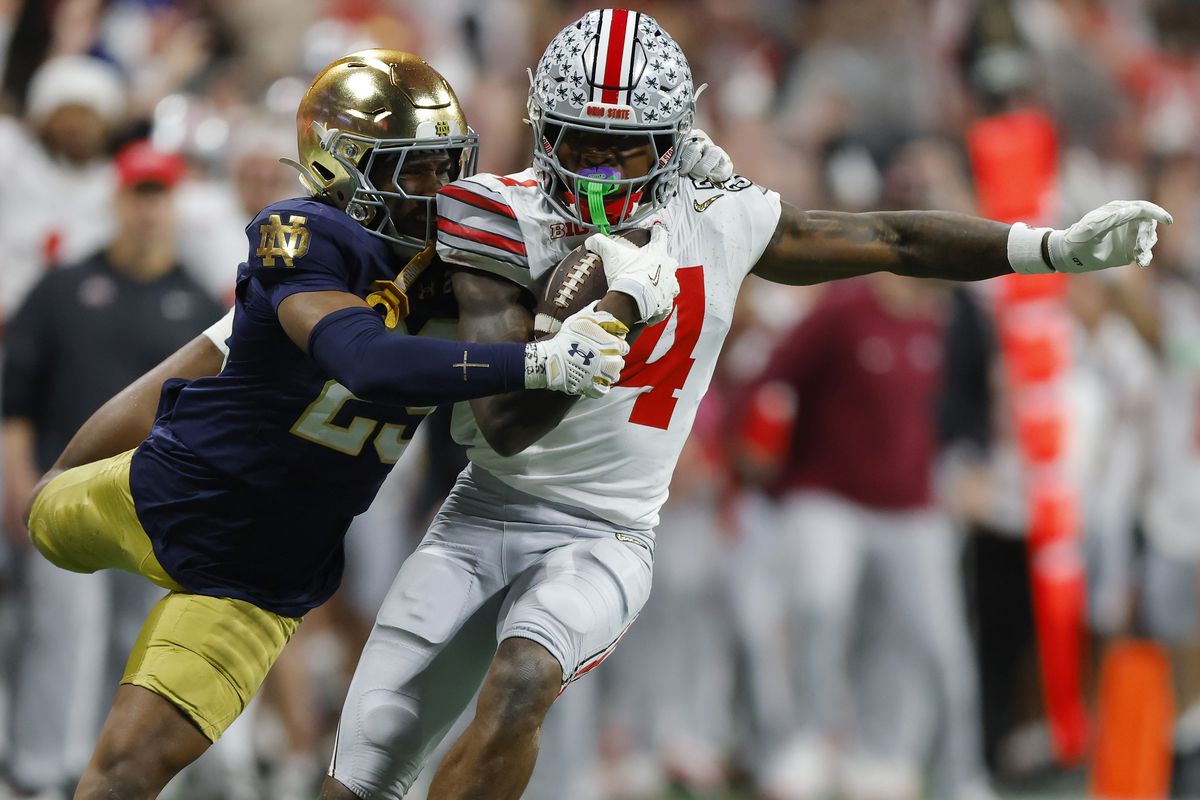
Ohio Stadium in Columbus becomes more than just a stadium on cool fall Saturdays. More than 100,000 worshippers descend upon the concrete and steel edifice, fondly referred to as “The Horseshoe” by the locals, for an experience that is very similar to religious worship, in addition to watching football. Instead of written holy scriptures, adherents of this nonreligious religion pass them down verbally from one generation to the next with the same respect given to ages-old knowledge.
Ohio State football’s linguistic roots foster a strong sense of community that borders on tribalism. Strangers aren’t just expressing team allegiance when they exchange “O-H” and “I-O” signs on a street in downtown or at an airport terminal across the nation; they are affirming participation in a cultural institution that goes beyond sports. These oral traditions serve as both reminders of the past and promises for the future, and they are emotionally heavy, making them difficult for outsiders to understand.
| Ohio State Football Traditions Data | |
|---|---|
| Team Colors | Scarlet and Gray |
| Stadium | Ohio Stadium (“The Horseshoe”) – Capacity: 102,780 |
| Fight Song | “Buckeye Battle Cry” |
| Mascot | Brutus Buckeye |
| Famous Rivalry | Michigan Wolverines (“The Game”) |
| Notable Coaches | Woody Hayes, Urban Meyer, Jim Tressel, Ryan Day |
| National Championships | 8 (1942, 1954, 1957, 1961, 1968, 1970, 2002, 2014) |
| Heisman Trophy Winners | 7 (Les Horvath, Vic Janowicz, Howard Cassady, Archie Griffin [2x], Eddie George, Troy Smith) |
| Official Website | Ohio State Athletics |
The profound impact these oral traditions have had on Ohioan culture and daily life is what makes them so interesting. Buckeye football lingo has spread well beyond the confines of stadiums, establishing linguistic links in apparently unconnected settings. During a recent business conference, I overheard two executives—clad in conservative suits and without any obvious team gear—ending the meeting with a discreet “Go Bucks” before shaking hands. Silently recognizing common ideals that go beyond football, this informal invocation worked as both a professional courtesy and a cultural identification.
Understanding the mental processes that give rise to these proverbs teaches us a lot about how groups come to be known. When a rookie quarterback utters the words “three yards and a cloud of dust” after a critical third-down conversion, he isn’t just making a passing reference to the grinding offensive philosophy of Woody Hayes; he is actively joining an uninterrupted line of predecessors that stretches back decades. In addition to situating the speaker inside that ongoing story, the term also serves as historical shorthand. With yearly roster changes and shorter and shorter coaching tenures, these language traditions provide emotional continuity to the sport.
Perhaps the best example of how language influences Buckeye Nation’s identity is the Michigan rivalry. It wasn’t just competitive gamesmanship; Woody Hayes’s famous non-use of the name “Michigan” in favor of the disparaging “That School Up North” was a calculated linguistic move. Hayes built a language framework that, ironically, elevated the rivalry’s significance while also diminishing the opponent by deleting their true name. Even the smallest statements may have a huge impact in a high-stakes game, therefore current players and coaches continue this tradition.
“I thought it was weird at first,” one anonymous transfer player said. However, I realized that I was engaging in the same behavior after a few months of the program. Refusing to utter their name makes them seem like something prohibited and frightening that we’re getting ready to confront. It creeps under your skin. This verbal taboo establishes clear boundaries for the outgroup while reinforcing in-group cohesion via psychological means.
Their incredible flexibility throughout ages is what sets Ohio State’s sayings apart from comparable traditions at other renowned institutions. From Hayes’ powerful rushing game to Ryan Day’s intricate passing assault, football techniques have changed drastically, but the fundamental language components have stayed the same. Urban Meyer’s “The Edge” attitude, which encourages athletes to discover and beyond their own personal limits, is reminiscent of Hayes’ “paralyze resistance with persistence” slogan from fifty years ago. Conceptual continuity despite practical upheaval is provided by these linguistic throughlines.
Jim Tressel’s focus on “The Buckeye Way”—a concept that encompasses athletic performance, intellectual accomplishment, and personal character—during his tenure as head coach had a substantial impact on this linguistic heritage. Aside from game performance, Tressel broadened the program’s linguistic history by expressing this larger concept of being a Buckeye. “The Buckeye Way” has evolved into a holistic value system, not just a football mindset, as current players often mention when talking about community involvement or academic achievements.
Authenticity is the key to these sayings’ potency. Buckeye football catchphrase did not originate in the marketing department but rather developed naturally over many years of play. Because they didn’t originate as slogans but rather crystallized organically from significant points in the program’s history, they have a lot of emotional weight. Standing together after games and singing “Carmen Ohio” (with arms linked) is a tradition that the team does that brings them closer to each and every squad that has played there before.
“These words might seem simple to outsiders,” said Margaret Thornton, a lifelong season ticket holder who hasn’t missed a home game since 1973. But they’re like a secret code that quickly brings back particular memories for those of us who have lived through the highs and lows. The very use of the words “Holy Buckeye” brings back all the feelings I had during the Purdue game in 2002. Fans of different generations may form strong ties via the shared experience of a shared language, even if they may not have much in common in real life.
The fact that these proverbs still strike a chord with fans despite college sports becoming more commercial is astounding. Optimistic views of college athletics find a safe haven in Ohio State’s linguistic traditions, which are especially important in an age when player transfers, name-image-likeness partnerships, and corporate sponsorships erode conventional ideas of school devotion. Amidst the ever-shifting landscape of modern consumerism, the language provides a sense of stability by bridging the gap between present-day experiences and their historical roots.
Articles of religion, or linguistic touchstones that define what it means to belong to this specific group, they are more than just motivating platitudes for Buckeye Nation. These proverbs serve as sacred text in the religious tradition of Ohio State football, which is revered and followed religiously. Their lasting impact goes beyond football tactics and competitive drive; they express a commonality that goes beyond sports, uniting millions of people through the stunning simplicity of language.



